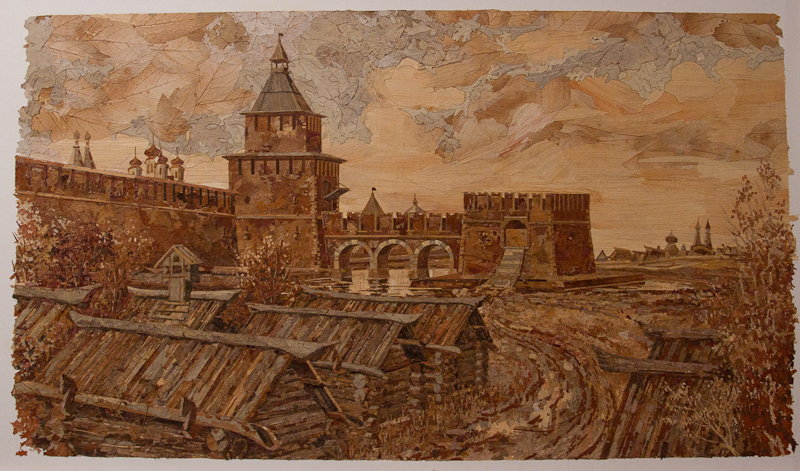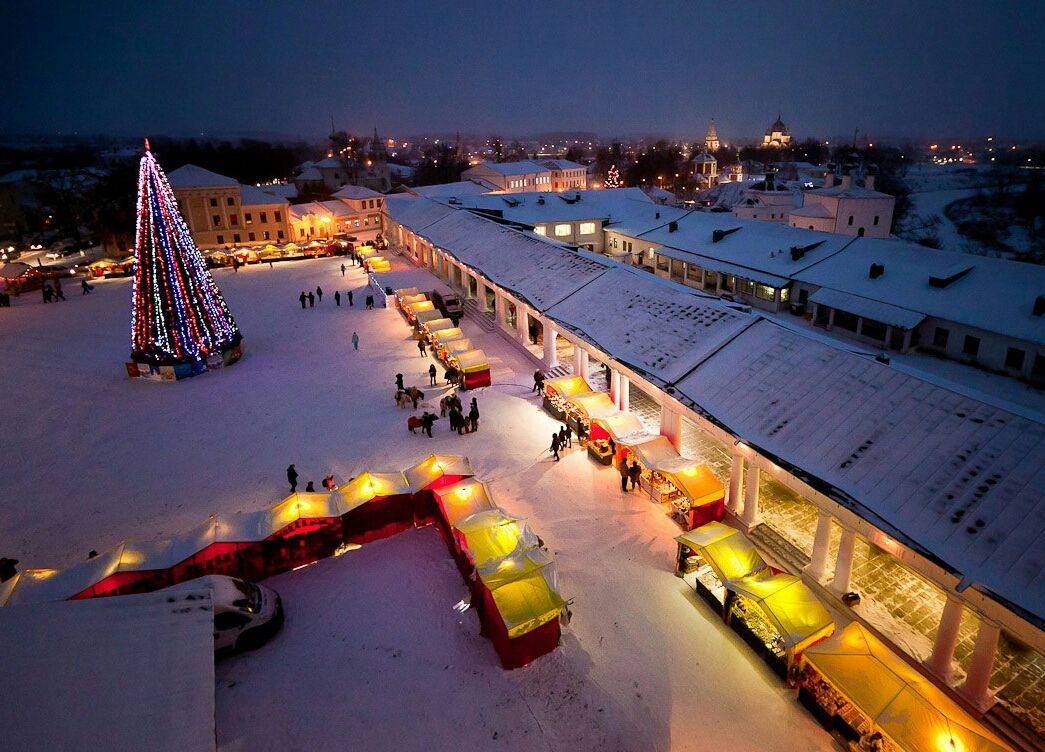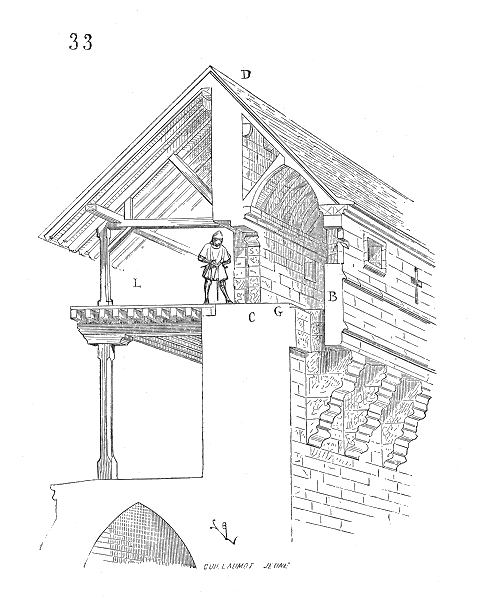|
Dmitrievskaya Tower
The Dmitrievskaya Tower () is the main tower on the southern wall of the Nizhny Novgorod Kremlin which overlooks the Minin and Pozharsky Square. The tower named after a powerful Prince of Suzdal and Nizhny Novgorod Dmitry of Suzdal. Another version claims that the name gave a church which was sanctified of the name of Saint Demetrius of Thessaloniki. This church was located opposite the tower. History The Dmitrievskaya Tower was built between 1500 and 1516 during the construction of the Nizhny Novgorod Kremlin. Its earliest mention comes in 1516 in the chronicle. After 1782 the Dmitrievskaya Tower began to disintegrate and redevelop. The Nizhny Novgorod Kremlin has been completely renovated between 1785 and 1790. Part of the tower above the gates was completely reconstructed. Wall thicknesses was reduced, loopholes were replaced by rectangular windows. Low slanting iron roof was erected. In the early 18th the Kremlin walls and the Dmitrievskaya Tower were traditionally painted ... [...More Info...] [...Related Items...] OR: [Wikipedia] [Google] [Baidu] |
Nizhny Novgorod
Nizhny Novgorod ( ; rus, links=no, Нижний Новгород, a=Ru-Nizhny Novgorod.ogg, p=ˈnʲiʐnʲɪj ˈnovɡərət, t=Lower Newtown; colloquially shortened to Nizhny) is a city and the administrative centre of Nizhny Novgorod Oblast and the Volga Federal District in Russia. The city is located at the confluence of the Oka (river), Oka and the Volga rivers in Central Russia, with a population of over 1.2 million residents, up to roughly 1.7 million residents in the urban agglomeration. Nizhny Novgorod is the List of cities and towns in Russia by population, sixth-largest city in Russia, the Volga#Biggest cities on the shores of the Volga, second-most populous city on the Volga, as well as the Volga Federal District. The city is located 420 kilometers (260 mi) east of Moscow. It is an important economic, transportation, scientific, educational and cultural centre in Russia and the vast Volga-Vyatka economic region, and the main centre of river tourism in Russia. In the his ... [...More Info...] [...Related Items...] OR: [Wikipedia] [Google] [Baidu] |
Russia
Russia, or the Russian Federation, is a country spanning Eastern Europe and North Asia. It is the list of countries and dependencies by area, largest country in the world, and extends across Time in Russia, eleven time zones, sharing Borders of Russia, land borders with fourteen countries. Russia is the List of European countries by population, most populous country in Europe and the List of countries and dependencies by population, ninth-most populous country in the world. It is a Urbanization by sovereign state, highly urbanised country, with sixteen of its urban areas having more than 1 million inhabitants. Moscow, the List of metropolitan areas in Europe, most populous metropolitan area in Europe, is the capital and List of cities and towns in Russia by population, largest city of Russia, while Saint Petersburg is its second-largest city and Society and culture in Saint Petersburg, cultural centre. Human settlement on the territory of modern Russia dates back to the ... [...More Info...] [...Related Items...] OR: [Wikipedia] [Google] [Baidu] |
Nizhny Novgorod Kremlin
The Nizhny Novgorod Kremlin () is a fortress (Kremlin (fortification), kremlin) in the Historic centre of Nizhny Novgorod, historic city center of Nizhny Novgorod, Russia. History The first attempt to replace the wooden fort with a stone Kremlin (fortification), kremlin was recorded in 1374, but construction was limited to a single tower, known as the Dmitrovskaya Tower (this has not survived). Under the rule of Ivan III, Nizhny Novgorod played the role of a guard city, having a permanent garrison; it served as a place for gathering troops for Moscow’s actions against the Khanate of Kazan. In order to strengthen the defenses of the city, construction works on the walls began again. Construction of the stone Kremlin of Nizhny Novgorod began in 1500 with the building of the Ivanovskaya Tower; the main work commenced in 1508 and by 1515 a building was completed. The oak walls that formed the old fortifications were destroyed by a huge fire in 1513. The two kilometer wall was re ... [...More Info...] [...Related Items...] OR: [Wikipedia] [Google] [Baidu] |
Minin And Pozharsky Square
The Minin and Pozharsky Square (), also known as just Minin Square, is the main square of Nizhny Novgorod. It is a social and cultural center of the city, the venue of the most important celebrations. It is located in the Historic centre of Nizhny Novgorod, historical centre of the old town from the southeast side of the Nizhny Novgorod Kremlin, Kremlin. The square connects the central streets of the city: Bolshaya Pokrovskaya Street, Bolshaya Pokrovskaya, Varvarskaya, Ulyanov, Minin, Upper Volga embankment and Zelensky Descent. There are many architectural monuments, the Minin University, N. I. Lobachevsky State University of Nizhny Novgorod, Lobachevsky University and the Research Medical University of Volga region, Medical University; monuments to Minin, Chkalov; Exhibition Complex, as well as the first city fountain. The square is the roadway. Movement on it overlaps only on holidays and at the time of other events. History Russian tsardom Before the square began to tak ... [...More Info...] [...Related Items...] OR: [Wikipedia] [Google] [Baidu] |
Suzdal
Suzdal (, ) is a Types of inhabited localities in Russia, town that serves as the administrative center of Suzdalsky District in Vladimir Oblast, Russia, which is located along the Kamenka tributary of the Nerl (Klyazma), Nerl River, north of the city of Vladimir, Russia, Vladimir. As of the Russian Census (2021), 2021 Census, its population was 9,286. In the 12th century, Suzdal became the capital of the principality. Currently, Suzdal is the smallest of the Russian Golden Ring of Russia, Golden Ring towns. It has several sites listed as World Heritage Site, UNESCO World Heritage Sites. History The town's history dates back to 999 and 1024. In 1125 Yuri Dolgorukiy, Yury Dolgoruky made Suzdal the capital of the Vladimir-Suzdal#Rostov-Suzdal, Rostov-Suzdal principality. In 1157, Andrey Bogolyubsky, Andrei Bogolyubsky moved the capital from Suzdal to Vladimir, from which time the principality was known as Vladimir-Suzdal. Suzdal was burned and plundered in 1237 during the Mo ... [...More Info...] [...Related Items...] OR: [Wikipedia] [Google] [Baidu] |
Dmitry Of Suzdal
Dmitry Konstantinovich (; 1323–1383) was Prince of Suzdal and Grand Prince of Nizhny Novgorod-Suzdal from 1365. He took the title of Grand Prince of Vladimir from his son-in-law, Dmitry Donskoy, from 1360 to 1363.Димитрий-Фома Константинович // Russian Biographical Dictionary The famous Shuisky family descends from his eldest son, [...More Info...] [...Related Items...] OR: [Wikipedia] [Google] [Baidu] |
Demetrius Of Thessaloniki
Saint Demetrius (or Demetrios) of Thessaloniki, Thessalonica (, ), also known as the Holy Great martyr, Great-Martyr Demetrius the Myroblyte (meaning 'the Myrrh-Gusher' or 'Myrrh-Streamer'; 3rd century – 306), was a Greeks, Greek Christianity, Christian martyr of the early 4th century AD. During the Middle Ages, he came to be revered as one of the most important Orthodox military saints, often paired with Saint George, Saint George of Lydda. In the Roman Catholic Church he is most commonly called Demetrius of Sirmium and his memorial is 9 April in the 2004 Roman Martyrology and 8 October in the martyrology of the Extraordinary Form. It is debated whether Demetrius of Thessalonica and Demetrius of Sirmium are the same person. Life The earliest written accounts of his life were compiled in the 9th century, although there are earlier images of him, and the 7th-century ''Miracles of Saint Demetrius'' collection. According to these early accounts, Demetrius was born to pious Chri ... [...More Info...] [...Related Items...] OR: [Wikipedia] [Google] [Baidu] |
Chronicle
A chronicle (, from Greek ''chroniká'', from , ''chrónos'' – "time") is a historical account of events arranged in chronological order, as in a timeline. Typically, equal weight is given for historically important events and local events, the purpose being the recording of events that occurred, seen from the perspective of the chronicler. A chronicle which traces world history is a universal chronicle. This is in contrast to a narrative or history, in which an author chooses events to interpret and analyze and excludes those the author does not consider important or relevant. The information sources for chronicles vary. Some are written from the chronicler's direct knowledge, others from witnesses or participants in events, still others are accounts passed down from generation to generation by oral tradition.Elisabeth M. C. Van Houts, ''Memory and Gender in Medieval Europe: 900–1200'' (Toronto; Buffalo: University of Toronto Press, 1999), pp. 19–20. Some used writ ... [...More Info...] [...Related Items...] OR: [Wikipedia] [Google] [Baidu] |
Machicolation
In architecture, a machicolation () is an opening between the supporting corbels of a battlement through which defenders could target attackers who had reached the base of the defensive wall. A smaller related structure that only protects key points of a fortification are referred to as Bretèche. Machicolation, hoarding, bretèche, and murder holes are all similar defensive features serving the same purpose, that is to enable defenders atop a defensive structure to target attackers below. The primary benefit of the design allowed defenders to remain behind cover rather than being exposed when leaning over the parapet. They were common in defensive fortifications until the widespread adoption of gunpowder weapons made them obsolete. Etymology The word machicolation derives from Old French , mentioned in Medieval Latin">-4; we might wonder whether there's a point at which it's appropriate to talk of the beginnings of French, that is, when it wa ... , mentioned in Medieval Lat ... [...More Info...] [...Related Items...] OR: [Wikipedia] [Google] [Baidu] |
Nicholas II Of Russia
Nicholas II (Nikolai Alexandrovich Romanov; 186817 July 1918) or Nikolai II was the last reigning Emperor of Russia, Congress Poland, King of Congress Poland, and Grand Duke of Finland from 1 November 1894 until Abdication of Nicholas II, his abdication on 15 March 1917. He Wedding of Nicholas II and Alexandra Feodorovna, married Alexandra Feodorovna (Alix of Hesse), Alix of Hesse (later Alexandra Feodorovna) and had five children: the OTMA sisters – Grand Duchess Olga Nikolaevna of Russia, Olga, born in 1895, Grand Duchess Tatiana Nikolaevna of Russia, Tatiana, born in 1897, Grand Duchess Maria Nikolaevna of Russia, Maria, born in 1899, and Grand Duchess Anastasia Nikolaevna of Russia, Anastasia, born in 1901 — and the tsesarevich Alexei Nikolaevich, Tsarevich of Russia, Alexei Nikolaevich, who was born in 1904, three years after the birth of their last daughter, Anastasia. During his reign, Nicholas gave support to the economic and political reforms promoted by his prim ... [...More Info...] [...Related Items...] OR: [Wikipedia] [Google] [Baidu] |
Yuri II Of Vladimir
Yuri II (, also transcribed as ''Iuri''), also known as George II of Vladimir or as Georgy II Vsevolodovich (26 November 11884 March 1238), was the fourth Grand Prince of Vladimir (1212–1216, 1218–1238) who presided over the Principality of Vladimir-Suzdal at the time of the Mongol invasion of Kievan Rus'. He was the seventh child and the third and best-loved son of Vsevolod III (Vsevolod the Big Nest) and of Maria Shvarnovna. He first distinguished himself in the battles against Ryazan in 1208. His father wanted Yuri to inherit Rostov and his elder brother Konstantin to succeed him in Vladimir. The latter, however, declared that he would rule both towns or nothing at all. Thereupon Vsevolod disinherited Konstantin and passed the throne to Yuri, who received the largest portion of his possessions. Before his death, grand prince Vsevolod divided his territories between his sons; as soon as he died in 1212, the Vladimir-Suzdal war of succession (1212– ... [...More Info...] [...Related Items...] OR: [Wikipedia] [Google] [Baidu] |
Historic Centre Of Nizhny Novgorod
The historic centre of Nizhny Novgorod (also old Nizhny Novgorod, the old town) is the downtown of Nizhny Novgorod with historical buildings in the borders up to 1917. A number of ancient buildings, natural landmarks and historic districts are found in the area. In the old city there are buildings of different epochs and architectural styles, including Byzantine Revival architecture, Neo-Byzantine, Stroganov's Baroque, Empire style, Empire, Art Nouveau, Modern. These include the medieval Nizhny Novgorod Kremlin, Kremlin, 19th-century mansions and Stalinist architecture, Stalinist monumental houses. Sites The site contains the following objects # Historic centre of Nizhny Novgorod (downtown); #* The Nizhny Novgorod Kremlin, Kremlin; #*Minin and Pozharsky Square, Upper Posad; #* The Nizhny Novgorod Fair, Fair; #* The Spit of Nizhny Novgorod, Spit (Strelka); #*Nizhny Novgorod railway station, Moskovsky railway station and Revolution Square; # Historic centre of Sormovsky City Distr ... [...More Info...] [...Related Items...] OR: [Wikipedia] [Google] [Baidu] |






